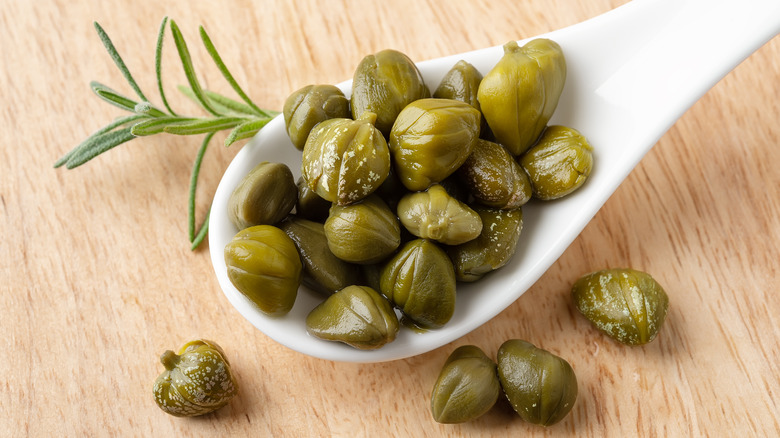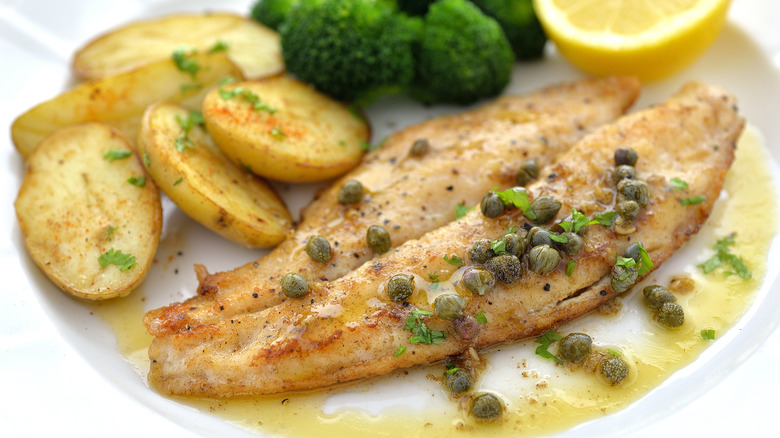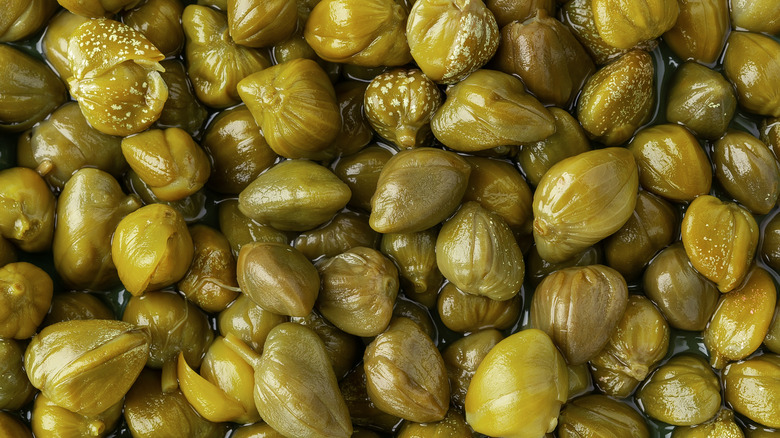Caper Compound Butter Is The Tangy Spread You're Sleeping On
You can't go wrong with butter; whether slathered on bread and eaten plain, used to baste a sumptuous steak, or drizzled atop steamed veggies, there are a limitless number of ways this rich dairy spread can be prepared and eaten. The pure stuff is classic for a reason, but elevating butter to another degree of deliciousness is as easy as combining it with some extra ingredients to form a compound butter: Butter that's been seasoned with extras like chopped herbs, spices, and more.
Ingredients like garlic, mushrooms, and lemon are all common additions to compound butter, but what about something a little less usual? Next time you're experimenting with compound butter, try tangy capers on for size.
What are capers, you may ask? These briny little buds, which are actually immature flowers that grow on a shrub primarily found in the Mediterranean (but also in Asia and Australia), add a ton of salty and sour flavor when chopped fine and thoroughly incorporated into softened butter (softening it to room temperature helps the ingredients mix more easily). About 2 tablespoons of capers per half-stick of butter is ideal. The result is a complex, tart, salty-creamy combination that pairs well with just about any dish that needs a touch of richness with a backdrop of brine.
Butter and capers are a perfect match
Butter and capers go excellently together; they're fantastic when compounded, but their combined power is evidenced in a number of other dishes as well. Piccata is a great example of the delicious convergence of capers and butter; along with lemon juice and parsley, the fattiness of the butter and the salinity of the capers offset one another to form a sauce that's both rich and bright with vinegary sourness and citrusy tartness. Hailing from the South of France, sauce Grenobloise takes things a step further by browning the butter. Fortunately, these flavors are easy to replicate in a compound butter (you can even use resolidified brown butter).
Another addition that goes well with capers and butter is fresh herbs, such as dill. This pairing is ideal with seafood, from mild white fish to bolder proteins like salmon, scallops, and lobster. In a video on Facebook, famed French chef and author Jacques Pépin goes wilder than Willie Nelson with the herbal component, chucking in not just dill, but basil, parsley, and chives along with the bodacious, salty buds. He doesn't stop there, pivoting to other edible flora like oregano flowers and squash blossoms. "Of course, you can use violets, roses, you can peonies," he notes. Because capers are so strongly flavored, they stand out even when mingling with a slew of other ingredients.
Pairings for caper compound butter
Caper compound butter can be used for a number of different applications, but some dishes were just made for this briny, buttery condiment. Of course, if you have some good bread, the butter makes an excellent simple spread on its own as part of a charcuterie spread. With the rise of butter boards and many home cooks venturing into the world of homemade flavored butter, variety is always welcome, and caper compound butter brings a unique, salty flavor to the board that other compound butters lack.
But compound butter can also make an easy topping for cooked vegetables; simply add a bit of the butter to freshly steamed or grilled veggies — especially mushrooms, squash, and asparagus, all of which pair well with the saltiness of capers. Once melted, the compound butter acts as a sauce, elevating a simple side dish into something a little fancier and more complete. Steak and even roast chicken both benefit from a similar application, though it's worth a try on almost anything savory. You're bound to become a fan of that characteristic buttery brine.


